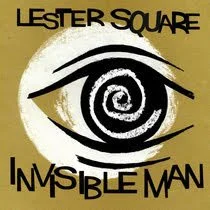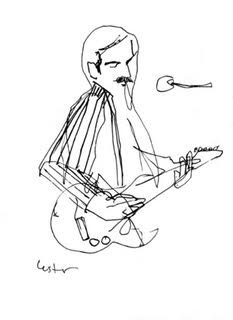Invisible Man by Lester Square
Lester Square’s 5th solo album was recorded at Liberal Elite Studios in Islington. On ‘Invisible Man’ Lester reveals a real passion for film music. Lester plays all instruments and has written all the tracks except Zulu which was composed by John Barry. Singer, artist and Le Doc regular Dr Mikey Georgeson heard the album at: https://lestersquare.bandcamp.com and told us this...
Whom the God's destroy – Reminds me of rejuvenated New Order smiling at each other across the studio. 8/10
Disco Bizarro – Gnarly groovesome and the "It's Alive" sample drives a Scary Monster hit. 7/10
Shinjuku – Keeps running up the hill backwards. A real grower with added Lester twang! 6/10
Trudi French (Slight Return) – Epic, Evocative and instantly compelling. Picture yourself rolling down a grassy knoll with ear buds in May. 9/10
The Claws of Tigron – A fun cinematic matinee interlude. Wobbly spaceships ahoy. 6/10
Destination Space – Statement of intent in aural sculpture as if Space was by the Seaside. 7/10
Time Tunnel – Prepare for blast off in a melancholy way. Unsettling conveyor-belt euphoria. 8/10
Leaf – Eno Ferdinand Culty even! I think we are approaching our destination feeling light headed! 7/10
Cop26 – A confidently reflective close to the album. Pure optimistic nihilism in cloud writing. 10/10
Bonus Track: Zulu – Amazing John Barry joins Rider Haggard in a live Tenpole Tudor style romp. 7/10
For an invisible man Lester Square is extremely prolific. Rather than hanging round rustling potted plants on the side of the screen to denote his presence beyond the Monochrome Set, he has recorded no less than five solo albums. This I confess is my first encounter with his solo output, which seems a little unfair as I’m such a fan of his work in his day job, for which he presumably dons a custom-made latex rubber mask of his real face. Fans, one of which I’ve now established myself, are a strange breed. They have a weird trance-like loyalty to the original source of their devotion. Or at least this is how it feels to me. For instance, I really want to like the solo Fred Schneider’s output but this feels disloyal to the B52s (my devotion to whom stretches to loving their LP Mesopotamia, which was recently demoted from LP to EP such is its perceived lack of weight). It seems I’m too late for the raw Lester Square does Lester Square albums (presumably abounding with trademark surf twang) and this one has a more “synthesised sound”. I rather like this antiquated turn of phrase in the press release, which makes it sound as if an Edwardian adventurer jumped in a time machine and laid their hands on one of those new-fangled synthesizing apparatuses.
I can remember, boys and girls, how I saved up all my shillings from a job at the green grocers and travelled with my parents to Camden to purchase just such a devise, one Roland Juno 6 – the programmable and therefore in my view more literal, Juno 60 would have meant a few more months toiling with rotten sacks of potatoes and pretending to like the brittle, abrasive folks with whom I had to set up shop and weigh bags of produce with a smile. Upon returning home with the synthesising machine the first thing my father and I did was to open the handbook. We manipulated the sliding knobs in the prescribed fashion and were astounded at how close to the real sound of violins the organ like fizz that emerged from the separate keyboard amplifier was. My father would carry this revelatory encounter with envelopes and filters with him for the rest of his life but I gradually realised that the thrill of a synthesiser was making it sound like, well, a synthesiser. I recently heard a multi-media artist saying how they liked combining real instruments and synthesiser sounds because it was a combination of fact and fiction. Pffft. This, ladles and jelly spoons, is as good an example of any of representational thinking. The point of synthesisers is not what can you make them sound like but how they can be made to sound. What is their capacity for the joy of material vitality? The felt intensity of the other worldly wonder emerging into this dull prescriptive world via the frequencies of, say, the twinkling melody at the start of Computer Love. Computers ironically have made finding this thrill of a synthesiser’s material agency a very difficult process. According to a certain translator, Brian Massumi, we live in the Empire of Like, that is to say a realm of analogous thinking where we find our bearings via comparative analogies. This is like this. The synthesiser sounds like a violin. The music sounds like Blancmange. The latter being the analogy I had in mind as the start of this review because in a way it made sense of the Invisible man title because the sound of the music triggered a Pavlovian urge to hear a male baritone entering the audio tapestry.
I was in a virtual (synthesised) lecture the other day and the artist was blithely throwing the phrase Post-modern around as I ducked behind a metaphorical kitsch patterned sofa. We live in the post post-modern time they declared but no one knows what to call it. Alter-modern or metamodern were phrases folks have trifled with over the last decade before finding the will to live leaving the body. The point is that from the Nineties onwards I began to feel like the phrase was the equivalent of the Scottish play. Saying it somehow vaporised any joy in the creative process like a toxic fairy-tale spell. I still have a vestige of this feeling even now and fear that I may well have terminated this review’s chances of life. But never the less we’ll go on. Modernism was a powerful waterfall of progress flowing down into the future and Post modernism was the plunge pool with everything all mixed up and all the habitual baton swapping of spiritual minimalist expression to pop art surface nihilism was churned up. All ideas were bobbing around together on the surface like conceptual detritus. I began to wonder if Lester Square hadn’t inadvertently landed in the plunge-pool in his time machine with the Morlock music critics looking on with a certain incredulousness morphing rapidly into rage. When the Art of Noise introduced sampling into pop music it carried the same vitality as any other weird audiological innovation, like-wise the stuttering of Paul Hardcastle’s N N N N N Nineteen. Now though computers essentially sample everything into the on-off binary code of anything goes. We used to be able to get our bearings by the particular sound of the synthesiser. We were able to locate ourselves by the sounds of the synthesiser and the era those specific sounds were developed within and consequently even the rather insipid sounds of early digital synthesisers such as the DX7 were seen as an improvement due to the lingering belief in technological progress. Poor time traveling Lester, however, has found himself making synthesised sampled music at a time when there is nothing to give him any traction. It’s hard for someone who started making music in the early 80s to make meta-liberated music using the 80s sound palette of artists like MGMT. As I began listening to The Invisible Man, the new LP from Lester Square, I felt thrust into a vortex of 80s synthesisers sounds filtered through the magic box of post-lockdown plug-ins.
Do not go in a voice whispered in my mind’s deepest darkest cave. It takes a brave or foolish man to enter this realm with nothing to limit their choices. Me I like to believe in unfiltered aesthetic ontology or working with everything as if it is matter for expression. Despite the album’s sci-fi/b-movie resonances, I suspect this cosmic plane of immanence is not where Lester Square is coming from. Or perhaps it is. The problem with this freedom from hierarchical judgement that post-modernism offered is that it forgot about the body or somatic understanding. Our musical experience was all in the black-box recorder head – ride on time r r r ride on time. A blissful region for completist librarians because it is all about signifiers and that other Scottish play word, semiotics. So what of feeling and felt intensities? These feelings of getting something beyond words are what I experience when I hear The Model or Confusion. These records use synthesisers as part of actual occasions and emerge rather than cite. There is something deathly about citation in music. So did The Invisible Man reach this place of revelatory emergence through the secret cave tunnel underneath the plunge pool of certain death? Let’s find out.
I am not sure that Lester Square is as troubled by me as this problem of citation. I once saw a programme about film music and had an actual seizure when the onscreen talking-head was enthusing about the sound wave of the string stabs in psycho he had had inked as a tattoo. Music is not a signifier it is extra-textual or even extra-sensory. This doesn’t mean that if you trust in the music as a cosmic region that even familiar sounds cannot become matter for expression. I think the above MGMT manage to do this and to an extent Empire of the Sun but they are more knowing about their use of eighties sounds and musical syntax. For a few songs I couldn’t get past my teenage love of the realm of synthesisers which seemed to bloom and die on the vine before my eyes. I thought about the deep longing I felt at a recent concert of said Blancmange (coincidently the only food stuff I have a phobia of) underneath Chelsea football stadium. A longing for when all of this felt emergent and not an attempt to summon the spirits of that bygone era. I left as Neil Arthur was crooning his way through the day before you came. It seems a strange time to make an eighties album when your own work was the antithesis of those eighties over- blown razzamatazz proto-celebs in its subversive dissociative tone. I don’t think a reflection of the eighties view of the future is what the Invisible man was meant to be but it felt like that, for a while. Whom the Gods Destroy the opening track is mightily impressive and sonically rich with a stirring surf guitar over what might be theme to a forgotten educational science programme (a good thing by the way!). Disco Bizarro has a Radio Ga Ga bass chug which jostles playfully with the Flash Gordon sound bites later in the Claws of Tigron. Time Tunnel is a really juicy slab of synth-bass-led instrumental pop that would give Thomas Dolby a run for his money even with Yello in the engine room. Listening to it I stopped thinking about what it sounds like and let the squelchy frequencies chew up my bubble gum brain and take me back to the, well, plane of immanence.
Now, this is the part where I reveal that I did, in actual fact, take a deep breath and swim all the way through the tunnel until I emerged with the Invisible Man in a new ultra hyper-aesthetic land of possibilities – the unknown land that time unremembered. Or at least I think I did. Perhaps I was dreaming. This tunnel en-trance began with the track Trudy French (a slight return) and came up with a sudden sharp intake of ozone-depleted breath with COP26 a track I had over-looked initially, in my tired and synaptically glitching brain, as a homage to THX1138. Trudi French (slight return) is without doubt the most instantly beguiling instrumental track I have heard in a long time. It evokes an atmosphere of longing for nights at the Kentish-Town Forum watching indie bands redefine our identities as fluid multicellular organisms, where we find meaning inside the event and our sweaty bodies merge in a swaying trance of hope. Even a somewhat lightweight lead synth sound cannot dispel the feeling of defiant optimism the tune evokes. There is no obvious tune but it stays in your head and I can summon it at will in much the same way that I could Reel around the Fountain. Curiously it is also a more flawed arrangement than the rest of the album. What is it about the cracks being where the light gets in?
The closing track, Copa26 is described as a serious look at science fact. With its genuinely arresting musicality, it does much more than round of the album (as the press release suggests). Like all the music I love, what I think this track did for me is reinvigorate real life as an emerging fiction. Letting the melancholic string synths wash over me, I felt like Charlton Heston slamming his fists into the sand, shrieking, "You maniacs! You blew it up! Damn you!” I saw the dust of 911 thick in the atmosphere of a planet home to the Empire of Like, a people who have stubbornly failed to jettison the hierarchies of power that come pre-installed with representational thinking. It is a profoundly moving piece of music and what I found remarkable is that it feels so articulate regarding Cop26 without words. Is this because all music is actually aesthetic fact? Cop26 is the album’s moment of backwards causality, where we can find meaning inside the event and then perhaps even go on to research the three pathways of decarbonisation or the odds of the world stabilising at 1.5 degrees centigrade (slim). Into an emergence of understanding through feeling is where synthesised pop sounds can lead but perhaps we first must flail our way through the vortex in the plunge pool of associative detritus. Or with moments of genius like Trudi French we simply feel the cosmic vitality of the universe and get down to the sound of Cop26’s optimistic nihilism. Godspeed Captain Lester Square at the wheel of spaceship planet Earth, I look forward to his Buckminster Fuller inspired concept opus!
Review by Mikey Georgeson
Greg Betza, Philadelphia 2013




